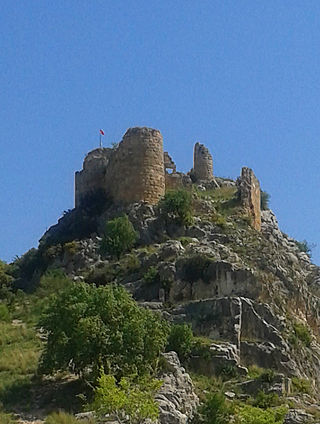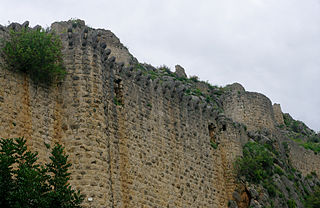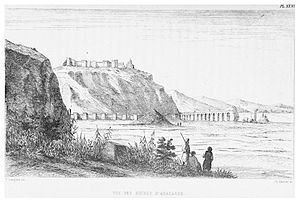
Anazarbus was an ancient Cilician city. Under the late Roman Empire, it was the capital of Cilicia Secunda. Roman emperor Justinian I rebuilt the city in 527 after a strong earthquake hit it. It was destroyed in 1374 by the forces of the Mamluk Empire, after their conquest of Cilician Armenia.

Cilicia is a geographical region in southern Anatolia in Turkey, extending inland from the northeastern coasts of the Mediterranean Sea. Cilicia has a population ranging over six million, concentrated mostly at the Cilicia plain. The region includes the provinces of Mersin, Adana, Osmaniye, along with parts of Hatay and Antalya.

Kozan, formerly Sis, is a city in Adana Province, Turkey, 68 kilometres northeast of Adana, in the northern section of the Çukurova plain. The city is the capital of the ilçe (district) of Kozan. The Kilgen River, a tributary of the Ceyhan, flows through Kozan and crosses the plain south into the Mediterranean. The Taurus Mountains rise up sharply behind the town.

The Cilician Gates or Gülek Pass is a pass through the Taurus Mountains connecting the low plains of Cilicia to the Anatolian Plateau, by way of the narrow gorge of the Gökoluk River. Its highest elevation is about 1000m.
Lampron is a castle near the town of Çamlıyayla in Mersin Province, Turkey. While part of the Armenian Kingdom of Cilicia in the Middle Ages, the castle was known as Lampron and was the ancestral home of the Armenian Hethumid princes. Situated in the Taurus Mountains, the fortress guarded passes to Tarsus and the Cilician Gates.
Düziçi is a town and district of Osmaniye Province in the Mediterranean region of Turkey. It is located in a small plain in the foothills of the Nur Mountains and 440 m above the sea level.
Toprakkale is a town and district of Osmaniye Province in the Mediterranean region of Turkey. It is located at 10 km to the west of Osmaniye. Its name comes from an Abbasid castle near the city.

Yılankale is a late 12th–13th century Armenian castle in Adana Province of Turkey. It is known in Armenian as Levonkla after its possible founder—King Leo (Levon) I the Magnificent of the Armenian Kingdom of Cilicia. Medieval Armenian names attached to the site are Kovara and Vaner.

Sarvandikar, also spelled Sarvanda k'ar. It was the Frankish castle of Savranda and is officially known today as Savranda Kalesi. The site is a medieval castle in the former Armenian Kingdom of Cilicia, located in Turkey's Osmaniye Province approximately 115 kilometers east of Adana.

Sis was the capital of the Armenian Kingdom of Cilicia. The massive fortified complex is just to the southwest of the modern Turkish town of Kozan in Adana Province.

Mamure Castle is a medieval castle in the Bozdogan village, Anamur ilçe (district) of Mersin Province, Turkey.

Silifke Castle is a medieval castle in Turkey.

Kızkalesi is an island castle situated on a small island in Mersin Province of Turkey.

Gözne Castle is a medieval castle in Mersin Province, Turkey.

Yaka Castle is a castle ruin in Mersin Province, Turkey. Although its name is Güdübeş, it is popularly known as Yaka referring to a former village to the east of the castle.

Bodrumkale is a castle ruin in Osmaniye Province, Turkey. It is situated on a hill, about 12 kilometres (7.5 mi) away from Osmaniye. The castle is to the northeast of the ancient city of Castabala. In medieval times it controlled the road from Central Anatolia to the Mediterranean coast. In 1973 an archaeological assessment and accurate plan were published. The castle is divided into two baileys or wards and has six towers. Most of its masonry was cut directly from the limestone outcrop and not plundered from the ancient city below. The lower level of the south tower functioned as a cistern. The survey was conducted under the auspices of the University of California at Berkeley.

Tece Castle is a ruined castle in Mersin Province, southern Turkey.

Kozan Castle is a castle in Kozan, Adana Province, Turkey.

Gülek Castle is a medieval castle in Mersin Province, Turkey.

Cilicia was one of the most important regions of the Middle East throughout history, who hosted the Hittite, Hellenistic, Roman, Armenian, and Islamic civilizations. Historically many people considered it as a part of the Levant, and during what is called the Rashidun Caliphate, much of its area was titled with the arabic name "Ath-Thugur As-Shamiyya"-carrying the meaning Levantine outskirts.





















